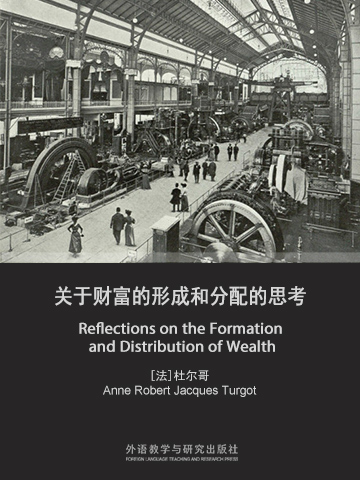被视为亚当•斯密的《国富论》的先驱。
Turgot's best known work, Réflexions sur la formation et la distribution des richesses (Reflections on the Formation and Distribution of Wealth), was written early in the period of his intendancy, ostensibly for the benefit of two young Chinese students. Written in 1766, it appeared in 1769–1770 in Dupont's journal, the Ephémérides du citoyen, and was published separately in 1776. Dupont, however, made various alterations in the text, in order to bring it more into accordance with Quesnay's doctrines, which led to a coolness between him and Turgot.
In the Réflexions, after tracing the origin of commerce, Turgot develops Quesnay's theory that the land is the only source of wealth, and divides society into three classes, the productive or agricultural, the salaried (the classe stipendiée) or artisan class, and the land-owning class (classe disponible). After discussing the evolution of the different systems of cultivation, the nature of exchange and barter, money, and the functions of capital, he sets forth the theory of the impôt unique, i.e. that only the net product (produit net) of the land should be taxed. In addition he demanded the complete freedom of commerce and industry.
在本书中,作者发挥了重农主义的基本原理。他在叙述商业的起源之后,论证了魁奈关于农业是财富的唯一泉源的观点。魁奈把社会划分为农业阶级(生产阶级)、工业阶级(非生产阶级)和土地所有者。作者加以补充,在农业阶级和工业阶级中又区分出资本家和雇佣工人。他把自由竞争的原则推广到劳动者和企业家的关系上,从而提供了当时最完备的工资理论。作者不仅把工资归结为最低限度的生活资料,而且详尽地说明了其所以如此的道理。其次,作者发挥了重农学派的净产品学说。他虽然也错误地把净产品(产品价值超过它的生产费用的余额)说成是自然界的赐予,但是他同时强调这是土地赐予耕作劳动的,实际上是劳动利用自然生产力的结果。在这里,他所说的自然赐予的农产品,正如马克思所说“秘密地转化为农业劳动者的剩余劳动”。在土地同劳动者分离的情况下,它被土地所有者无偿地占有了。从这里可以看出,在农业范围内,作者正确地理解了剩余劳动所创造的剩余价值,不过他是在具体劳动形态上来理解剩余劳动的。
Turgot's best known work, Réflexions sur la formation et la distribution des richesses (Reflections on the Formation and Distribution of Wealth), was written early in the period of his intendancy, ostensibly for the benefit of two young Chinese students. Written in 1766, it appeared in 1769–1770 in Dupont's journal, the Ephémérides du citoyen, and was published separately in 1776. Dupont, however, made various alterations in the text, in order to bring it more into accordance with Quesnay's doctrines, which led to a coolness between him and Turgot.
In the Réflexions, after tracing the origin of commerce, Turgot develops Quesnay's theory that the land is the only source of wealth, and divides society into three classes, the productive or agricultural, the salaried (the classe stipendiée) or artisan class, and the land-owning class (classe disponible). After discussing the evolution of the different systems of cultivation, the nature of exchange and barter, money, and the functions of capital, he sets forth the theory of the impôt unique, i.e. that only the net product (produit net) of the land should be taxed. In addition he demanded the complete freedom of commerce and industry.
- Reflections on the Formation and Distribution of Wealth.























 京公网安备 11010802032529号
京公网安备 11010802032529号
笔记加载中...